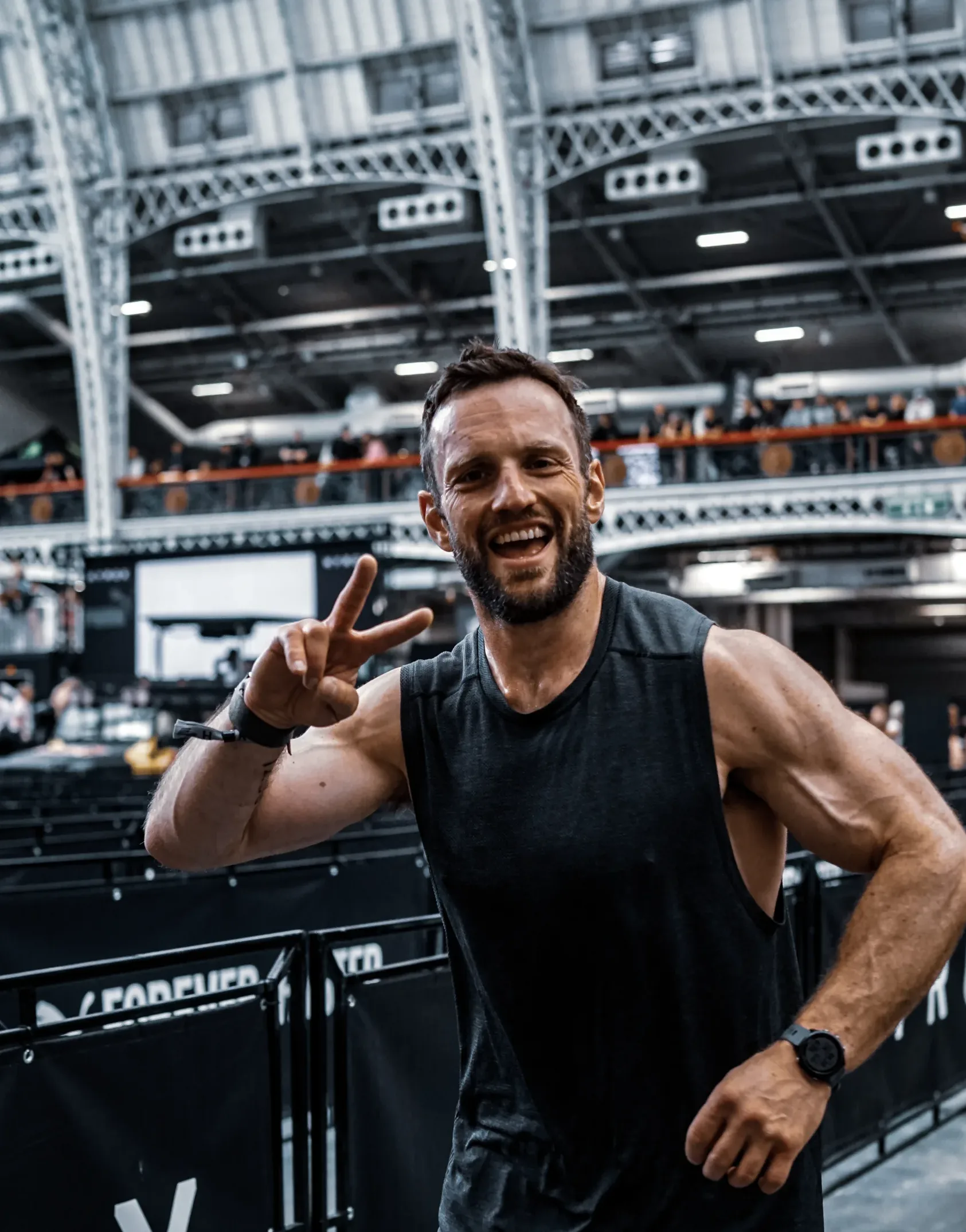How to Train for a Hyrox Competition

A new competition has arisen alongside the trending buzzword “hybrid athlete”. It’s called Hyrox, and it’s growing rapidly in international popularity. Why? And how can you prepare for a Hyrox competition to make sure you don’t place dead last?
Fred Ormerod is a freelance coach, army reserve medic, nurse, master’s student, and massage therapist. He’s spent a decade working in healthcare and five years coaching in one of Edinburgh’s leading training facilities.
Fred Ormerod


Change the Way You Train
What is Hyrox?
Hyrox is described as a fitness race for everyone. I’ve also heard it described as ‘CrossFit light’ since the events focus on easier functional movements, but leave out the complex barbell and gymnastic work. (Though personally, I try not to make burpees a functional part of my life wherever possible.)
Success appears to be based largely on aerobic capacity and an ability to push hard across the 8 different stages of the events and the sandwiched 1 km runs. Races can be performed at an open level (open to all), individual pro level (which includes heavier weights), doubles and relay teams.
Where the sport differs from CrossFit most importantly is in the simplicity of the movements. Where a CrossFit event separates groups based on elite skills such as advanced gymnastics, Hyrox events use movements that are more inherently doable. Farmer’s carries and sled drags don’t need hours of practice to perfect.
The beauty of Hyrox, however, is that any time spent in the gym is likely going to have some benefit on how you perform at the events, especially if you’re at a beginner level. Certain movements or attributes are important, namely running (see my article from March 2022) since you’re going to have to complete 8 stretches of running between different movements.
Breaking Down the Hyrox Movements
Some events might demand greater strength, such as farmer’s carries, or sled push/pulls, which will always be improved by increasing your absolute strength in these. Nonetheless, a focus on endurance should take some precedence.
In fact, none of the weights, even at a professional level, appear very difficult at first glance. In particular, note that your body mass will help in moving the sled before you even need to think about exerting yourself really hard.
|
Event |
Women |
Men |
Women Pro |
Men Pro |
|
Skierg |
1000m |
1000m |
1000m |
1000m |
|
Sled push |
102kg |
152kg |
152kg |
202kg |
|
Sled pull |
78kg |
103kg |
103kg |
153kg |
|
Burpee broad jumps |
80m |
80m |
80m |
80m |
|
Rowing |
1000m |
1000m |
1000m |
1000m |
|
Farmers carry 200m |
2x16kg |
2x24kg |
2x24kg |
2x32kg |
|
Lunges 100m |
10kg |
20kg |
20kg |
30kg |
|
Wall balls |
75 reps 4kg |
100 reps 6kg |
100 reps 6kg |
100 reps 9kg |

Let’s Get to Work
The bulk of your time should be spent on “energy system training” as follows:
Aerobic Zone 2
You’ll want to put some solid focus on zone 2 work. This type of training is performed at an easy intensity, one in which you can maintain a conversation, for increasing periods of time. Start with a minimum of 40 minutes and work up to an hour of zone 2 work every few days.
Realistically, you’ll want to rotate between rowing, skierg, and running to help build your aerobic capacity. Be sure not to avoid the one you’re the worst at! This will improve your aerobic capacity (ability to endure long periods of sub-maximal effort) as well as provide a long list of health benefits.
Stroke Volume & Lactate Threshold
Stroke volume training is NASTY. Making your heart pump blood more efficiently should be like something out of a movie montage when you think about it though. Bursts of maximum effort with good rest periods will improve heart rate variability (HRV) and enable you to push hard in each stage of the event, especially those with greater loads over distance.
More importantly, it will improve the ability of your heart to adjust to imposed demands appropriately; which is useful in a race where you might look to conserve some energy while running to push harder through a burpee stretch.
I like hill sprints for this, but rowing machines and similar CV kit will suffice alongside burpees or sled work if you want to keep it competition specific.
Lactate builds up in our muscles when we exercise in the absence of enough oxygen. This is the burn you start to feel when exerting yourself, for example in sprint training. The level at which you need to train to improve your lactate threshold will vary depending on experience. The fitter/more experienced you are, the greater effort you’ll need to reach the threshold where you can feel the lactic acid start to build. That’s when you back off to stay in the “lactate zone”.
Don’t Forget to Fuel Yourself!
You should also focus on nutrition/fueling yourself adequately to support competing and training across different energy systems. This is a great excuse to re-feed depleted glycogen stores after intense anaerobic training sessions! For a better understanding of fueling and refueling with carbohydrates check out my article on carbohydrates here.
As a general rule, carbs and protein post workout (roughly 30g) is a good idea in terms of recovery and roughly 1.6-2g per kg of body weight per day is best for training athletes.
A good balance of fats (up to a considered calorie intake) will also help in preventing fatigue, injuries, burn out and illness.
For help smashing your first Hyrox, check out my 8 week program which includes nutrition guidance to get you on your way!
Find Your Perfect Training Plan
Sometimes all you need to reach your destination on your fitness journey is an expert guide. We've got you covered. Browse from thousands of programs for any goal and every type of athlete.
Try any programming subscription free for 7 days!
Related articles
3 Ways to Improve Mobility Without Stretching
Are you still trying the endless foam rolling and stretching exercises to get that deep squat position? We know how important mobility is for great, or even GOOD performance. All professional athletes have some comfortability in end ranges of motion. So, what else do...
The Ultimate Guide to Lunges: Queen of all Glute Exercises
Your glutes are the largest muscle group in your body. They’re responsible for almost everything your legs do—walking, running, jumping, squatting, lunging, and just standing upright. As far as moving through space goes, strong glutes are the bedrock of overall...
A Beginner’s Guide to Steel Mace Training
Author: Jesse Grund
Mace training will make you a better mover without it’s not confining you to a fixed space or predetermined range of motion. Second, it’s an offset load with 80 to 90 percent of the weight in the head. You’re also constantly having to resist rotation, which creates greater core engagement.

Join the community
Sign up for the latest training news and updates from TrainHeroic
Made with love, sweat, protein isolate and hard work in Denver, CO
© 2023 TrainHeroic, Inc. All rights reserved.






